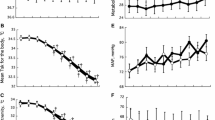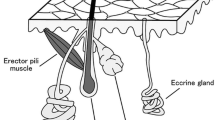Abstract
To examine whether cutaneous active vasodilatation is mediated by sudomotor nerve fibres we recorded cutaneous blood flow and sweat rates continuously with laser-Doppler flowmetry and capacitance hygrometry, respectively, from the dorsal and plantar aspects of the foot in 11 male subjects at varying ambient temperatures (T a) between 22 and 40°C (relative humidity 40%). In a warmer environment (T a 29–40°C), predominant responses of the blood flow curve from the sole of the foot were transient depressions (negative blood flow responses, NBR), whereas those from the dorsal foot were transient increases (positive blood flow responses, PBR). The PBR on the dorsal foot occurred spontaneously or in response to mental or sensory stimuli, and when PBR did not fuse with each other the rate of PBR was linearly related to tympanic temperature. When dorsal foot sweating was continuous, PBR on the dorsal foot almost entirely synchronized with sweat expulsion. When dorsal foot sweating was intermittent PBR sometimes occurred on the dorsal foot without corresponding sweat expulsions, but these PBR showed a complete correspondence with subthreshold sweat expulsion seen on a methacholine-treated area. The amplitude and the duration of PBR showed a significant linear relationship with the amplitude and the duration of the corresponding sweat expulsion. In a thermoneutral or cooler environment (T a 22–29°C), PBR occurred on the sole of the foot when mental or sensory stimuli elicited sweating in that area. Thus, PBR occurred when and where sweating appeared. Atropine failed to abolish PBR on the dorsal foot. Blockade of the peroneal nerve eliminated both PBR and NBR on the dorsal foot. The results indicate that an active vasodilatation mechanism is present on the sole of the foot as well as on the dorsal foot, and thus suggest that active vasodilatation is closely related to sudomotor nerve activation.
Similar content being viewed by others
References
Bell C, Jänig W, Kümmel H, Xu H (1985) Differentiation of vasodilator and sudomotor responses in the cat paw pad to preganglionic sympathetic stimulation. J Physiol (Lond) 364:93–104
Blair DA, Glover WE, Roddie IC (1960) Vasomotor fibres to skin in the upper arm, calf and thigh. J Physiol (Lond) 153:232–238
Blumberg H, Wallin BG (1987) Direct evidence of neurally mediated vasodilatation in hairy skin of the human foot. J Physiol (Lond) 382:105–121
Brengelmann GL, Freund PR, Rowell LB, Olerud JE, Kraning KK (1981) Absence of active cutaneous vasodilation associated with congenital absence of sweat glands in humans. Am Physiol 240 H571-H575
Edholm OG, Fox RH, Macpherson RK (1957) Vasomotor control of the cutaneous blood vessels in the human forearm. J Physiol 139:455–465
Elam M, Wallin BG (1987) Skin blood flow responses to mental stress in man depend on body temperature. Acta Physiol Scand 129:429–431
Fox RH, Hilton SM (1958) Bradykinin formation in human skin as a factor in heat vasodilatation. J Physiol (Lond) 142:219–232
Grant RT, Bland EF (1931) Observations on arteriovenous anastomoses in human skin and in the bird's foot with special reference to reaction to cold. Heart 15:385–407
Greenfield ADM (1963) The circulation through the skin. In: Hamilton WF (ed) Handbook of physiology. Circulation, section 2, vol. II. American Physiological Society, Washington DC, pp 1325–1351
Gregor M, Jänig W, Riedel W (1976) Response pattern of cutaneous postganglionic neurones to the hindlimb on spinal cord heating and cooling in the cat. Pflügers Arch 363:135–140
Hartschuh W, Reinecke M, Weihe E, Yanaihara N (1984) VIP-Immunoreactivity in the skin of various mammals: immunohistochemical, radioimmunological and experimental evidence for a dual localization in cutaneous nerves and Merkel cells. Peptides 5:239–245
Hirata K, Nagasaka T, Noda Y (1988) Partitional measurement of capillary and arteriovenous anastomotic blood flow in the human finger by laser-Doppler-flowmeter. Eur J Appl Physiol 57:616–621
Iwase S, Mano T, Sugenoya J, Saito M, Hakusui S (1988) Relationships among skin sympathetic nerve activity, sweating, and skin blood flow. Environ Med 32:55–67
Johnson JM, Taylor WF, Shepherd AP, Park MK (1984) Laser-Doppler measurement of skin blood flow: comparison with plethysmography. J Appl Physiol Respir Environ Exerc Physiol 56:789–803
Kolka MA, Stephenson LA, Allan AE, Rock PB (1989) Atropineinduced cutaneous vasodilation decreases esophageal temperature during exercise. Am J Physiol 257 R1089-R1095
Kuno Y (1956) Human perspiration. Thomas, Springfield. III., pp 98–124 and 141–156
Love AHG, Shanks RG (1962) The relationship between the onset of sweating and vasodilatation in the forearm during body heating. J Physiol (Lond) 162:121–128
Lundberg JM, Hökfelt T, Schultzberg M, Uvnäs-Wallensten K, Kohler C, Said SI (1979) Occurrence of vasoactive intestinal polypeptide (VIP)-like immunoreactivity in certain cholinergic neurons of the cat: evidence from combined immunohistochemistry and acetylcholinesterase staining. Neuroscience 4:1539–1559
Lundberg JM, Änggåd A, Fahrenkrug J, Hökfelt T, Mutti V (1980) Vasoactive intestinal polypeptide in cholinergic neurons of exocrine glands: functional significance of coexisting transmitters for vasodilation and secretion. Proc Natl Acad Sci USA 77:1651–1655
Lundberg J, Norgren L, Rosen I, Steen S, Thörne J, Wallin G (1989) Direct evidence of active sympathetic vasodilatation in the skin of the human foot. J Physiol 417:437–446
McCook RD, Wurster RD, Randall WC (1965) Sudomotor and vasomotor responses to changing environmental temperature. J Appl Physiol 20:371–378
Nordin M (1990) Sympathetic discharges in the human supraorbital nerve and their relation to sudo- and vasomotor responses. J Physiol 423:241–255
Oberle J, Elam M, Karlsson T, Wallin BG (1988) Temperature-dependent interaction between vasoconstrictor and vasodilator mechanisms in human skin. Acta Physiol Scand 132:459–469
Ogawa T, Bullard RW (1972) Characteristics of subthreshold sudomotor neural impulses. J Appl Physiol 33:300–305
Roddie IC (1983) Circulation to skin and adipose tissue. In: Shepard JT, Abboud FM (eds) Handbook of physiology, the cardiovascular system, vol. III, part 1, chap. 10. American Physiological Society, Bethesda, pp 285–317
Roddie IC, Shepherd JT, Whelan RF (1957) The contribution of constrictor and dilator nerves to the skin vasodilatation during body heating. J Physiol (Lond) 136:489–497
Rowell LB (1981) Active neurogenic vasodilatation in man. In: Vanhoutte PM, Leusen I (eds) Vasodilatation. Raven Press, New York, pp 1–17
Salerud EG, Tenland T, Nilsson GE, Öberg PA (1983) Rhythmical variations in human skin blood flow. Int J Microcire Clin Exp 2:91–102
Senay LC, Christensen M, Hertzman AB (1961) Cutaneous vasodilatation elicited by body heating in calf, forearm, cheek, and ear. J Appl Physiol 16:655–659
Sugenoya J, Ogawa T, Asayama M, Miyagawa T (1982) Occurrence of mental and thermal sweating on the human axilla. Jpn J Physiol 32:717–726
Sugenoya J, Iwase S, Mano T, Ogawa T (1990) Identification of sudomotor activities in cutaneous sympathetic nerves using sweat expulsion as the effector response. Eur J Appl Physiol 61:302–308
Tainio H, Vaalasti A, Rechardt L (1987) The distribution of substance P-, CGRP-, galanin- and ANP-like immunoreactive nerves in human sweat glands. Histochem J 19:375–380
Vaalasti A, Tainio H, Rechardt L (1985) Vasoactive intestinal polypeptide (VIP)-like immunoreactivity in the nerves of human axillary sweat glands. J Invest Dermatol 85:246–248
Yamashita Y, Ogawa T, Ohnishi N, Imamura R, Sugenoya J (1987) Local effect of vasoactive intestinal polypeptide on human sweatgland function. Jpn J Physiol 37:929–936
Author information
Authors and Affiliations
Rights and permissions
About this article
Cite this article
Sugenoya, J., Ogawa, T., Jmai, K. et al. Cutaneous vasodilatation responses synchronize with sweat expulsions. Europ. J. Appl. Physiol. 71, 33–40 (1995). https://doi.org/10.1007/BF00511230
Accepted:
Issue Date:
DOI: https://doi.org/10.1007/BF00511230




